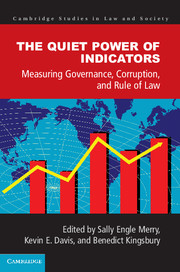Book contents
- Frontmatter
- Contents
- Notes on Contributors
- Acknowledgments
- Introduction: The Local-Global Life of Indicators: Law, Power, and Resistance
- PART I GLOBAL INDICATORS OF GOVERNANCE, CORRUPTION, AND RULE OF LAW
- 1 International Organizations and the Production of Indicators: The Case of Freedom House
- 2 Indicators and the Law: A Case Study of the Rule of Law Index
- 3 Measuring Corporate Accountability through Global Indicators
- 4 The Quest for Measuring Development: The Role of the Indicator Bank
- 5 Tradeoffs in Accountability: Conditionality Processes in the European Union and Millennium Challenge Corporation
- Part II INDICATORS IN LOCAL CONTEXTS
- Index
- Books in the Series
- References
1 - International Organizations and the Production of Indicators: The Case of Freedom House
from PART I - GLOBAL INDICATORS OF GOVERNANCE, CORRUPTION, AND RULE OF LAW
Published online by Cambridge University Press: 05 June 2015
- Frontmatter
- Contents
- Notes on Contributors
- Acknowledgments
- Introduction: The Local-Global Life of Indicators: Law, Power, and Resistance
- PART I GLOBAL INDICATORS OF GOVERNANCE, CORRUPTION, AND RULE OF LAW
- 1 International Organizations and the Production of Indicators: The Case of Freedom House
- 2 Indicators and the Law: A Case Study of the Rule of Law Index
- 3 Measuring Corporate Accountability through Global Indicators
- 4 The Quest for Measuring Development: The Role of the Indicator Bank
- 5 Tradeoffs in Accountability: Conditionality Processes in the European Union and Millennium Challenge Corporation
- Part II INDICATORS IN LOCAL CONTEXTS
- Index
- Books in the Series
- References
Summary
WHY ARE INDICATORS PRODUCED?
Global indicators, which purport to render characteristics of states measurable and comparable across national borders, have become ubiquitous in news reports and public policy discussions. Global indicators assess and rank states on every basis: medical care, education, and business regulatory environment, as well as more abstract concepts such as “freedom.” Some indicators, for instance, gross domestic product, have long served as foundations of policy analysis (despite known limitations; see Stiglitz et al. 2009a, 21–40, 85–142), while newer indicators, such as “state fragility,” have achieved prominence only recently (Bhuta 2012).
Initially, scholarly attention lagged behind the policy influence and public prominence of indicators, but research into indicators has developed significantly in recent years, including in the form of numerous books, articles, and policy reports (e.g., Morse 2004; Arndt 2008; Davis et al. 2012b; Cooley and Snyder, forthcoming). Nonetheless, as the editors of this volume observed in a previous article (Davis et al. 2012a, 4), “little attention has been paid to questions such as: What social processes surround the creation and use of indicators? How do the conditions of production influence the kinds of knowledge that indicators provide?” They noted that “the answers to these questions all have significant normative, theoretical and practical implications” (Davis et al. 2012a, 4; see also Halliday 2012; Pistor 2012).
Using the prominent indicator producer Freedom House as a case study, this chapter proposes some answers to these questions and sketches some normative, theoretical, and practical implications. The historical evidence from Freedom House's archives suggests that its indicator production was motivated predominately by the goal of strengthening Freedom House's own institutional identity and reputation. Among other things, the indicator appealingly defined Freedom House's “brand,” which in turn enhanced its ability to raise funds (including most importantly from the United States government), which in turn allowed the organization to engage in widespread “pro-freedom” activist efforts around the world.
- Type
- Chapter
- Information
- The Quiet Power of IndicatorsMeasuring Governance, Corruption, and Rule of Law, pp. 27 - 74Publisher: Cambridge University PressPrint publication year: 2015
References
- 11
- Cited by



